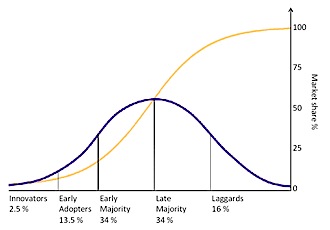I continue to have some discussions in comments of my Scienceblogs post that results in a treatise on my part. Greg Laden is the most recent victim of my verbosity – he has a great blog.
And, as with the previous reply to David Croty, I’ve decided to put it up as a post. Mainly because I wrote so much that it deserves more recognition with its own title, for instance. Plus it is very late and I do not feel like cutting it all down. I hope it looks okay in the morning.
So I make it a post. But it covers some more of my thoughts about the community that has been forming at Scienceblogs and where it will go from here.
First, Greg’s comment:
Just to expand on the point a little: For the most part, Scienceblogs has been explicitly non-communal. It is a network, there are communication channels (but not used by most bloggers) and things do get organized now and then (like a fundraising drive that about 20% of the blgogers engage in every year).
This is all very much on purpose. We blog as indy bloggers, and the ‘overlords’ (Seed’s Sb staff) organize all this internal network wide link love (reader’s picks, ed’s picks, most active, Page 3.14, the front page, 24 hour page, RSS feeds, etc.) and make links between things like NYT and NGS. But as bloggers, we’re just blogging away.
In once sense, I would say that PepsiBlawg Gate was an example of a “community” forming out of a thing that really wasn’t much of a community because most bloggers had fairly negative feelings about the blog so some degree of organization happened.
It would be interesting in the end to look at the kinds of things people do and their reaction to the Pepsiblog. There may be some stark (and thus perhaps not really that interesting in the end) patterns there. For the most part, labby research scientists did not quit, journalists and book writers did, for instance. Which brings up a point that Bora has almost talked me out of but not quite yet: Journalistic modus operendi, ethics, etc. are fundamentally different than for scientists. Not saying one is better than the other … just that they are fondling different parts of the elephant.
Which is a thought I’ll leave you with but I don’t recommend keeping in your head for too long.
My reply:
Even though my connection with the Scienceblog community was as a reader and sometimes commenter, as a scientist I feel confident that I can provide an opinion (My family knows that I have an opinion on everything so maybe that is a personal trait rather than a professional one. But ‘as a scientist’ sounds better than ‘as a know-it-all’). Confident mainly because I have been a part of several real-life enactments of just such a ‘community’ of researchers, connected by weak ties, who, through a precipitating event by ‘outsiders,’ came together to take some sort of action.
So, I think to a certain degree we may be arguing semantics about what really defines a community. In large measure, Scienceblogs is a network with mostly weak ties, but with some links perhaps a little stronger than others. And while there was not a decided push to create a defined community with uniform rules, titles and positions, when humans work along the same lines, doing similar things – even in digital space – connections get made and a sense of comity starts to emerge.
Thus insider slang terms like Sciblings, blogchild and Overlords developed. You would see memes and arguments sweep through certain blogs. There obviously were some strong connections that provided rapid information transfer between Sciblings.
There was an nascent community just waiting for an event that would precipitate action, making many weak ties much stronger, while breaking some altogether.
In the instances I have been involved in, a bunch of independent-minded, “leave me alone to do my work” researchers came together because a decision was made by upper management that directly affected the scientists – a decision that was never discussed with them until AFTER it was made. The scientists were left out of any input in the decision, even though it affected every single one of them.
In each case, there was a rapid meeting called by the researchers to discuss what they should do. Scientists who had never been in the same room with each other were now discussing the proper response with each other. Action had to be taken and committees were formed.
Instead of a bunch of weakly tied people, there were now a lot of very strongly defined paths for communication.
Perhaps this is only an aspect of egomaniac researchers, who think they have to be informed beforehand about anything and have a part of every decision. I do not think so. I think it can happen with any community when the weak ties that are present are tugged by an outside “threat.”
Heck, I’ve seen it happen in neighborhoods when a new development appears on the city plans.
What I think happened with the PepsiBlawg Gate was a crystallization of a large fragment of the network because, to some, it became obvious that the reasons they had joined and maintained even weak ties in the network /community were in conflict with what the ‘Overlords’ wanted to do. The lack of communication, and the ‘disrespect’ that engendered, meant some sort of response was needed.
And I’ve been fascinated by that response, because it has taken many forms. Some people exited without any need for real consultation. Some did not begin to really think about it until others in the network/community that they respected made a decision – Bora being the strongest example. Still others, such as PZ, decided to take direct action and go on strike unless the ‘Overlords’ listened to them.
These are all ways one would expect different people in a community to respond to change. It is what I spend my days examining at SpreadingScience.
I do not think Scienceblogs will vanish. It’ll be different. I think there will be much more defined communication between members, with regular meetings between the bloggers and the people from Seed Media. Instead of an ad hoc sort of network/community, it may very well become a much more defined one. Like the taming of the Old West, it may be more or less attractive, depending on the outlook of the individual. The bloggers who left may very well continue to link and discuss things written on Scienceblogs. The reverse will also happen.
In effect, there will be a much wider network/community with some very strong, defined ties that were not present before. I expect other types of science blogging sites to become important – such as Science 2.0 and others. It’ll be great for most of the bloggers and their readers. It may just not be quite as optimal for Seed as it had been before when they virtually had cornered the market.
And that was kind of my point in the post. If Seed had been a little better about servicing its bloggers, it would have kept the market pretty much to itself. Now, not so much. Meaning that, as far as it might be concerned, there is a loss in value that might take some effort to recreate. Effort that it would not have needed if it had not ticked people off.
Finally, I think that the different viewpoints between scientific journalists and journalistic scientists makes for a much better description of the elephant than either alone. In any effective network/community, diversity of world views is a key part. It is very hard to solve complex problems over and over if everyone thinks the same way. It is the friction that arises from the different views that eventually allows us to make the wise decision.








